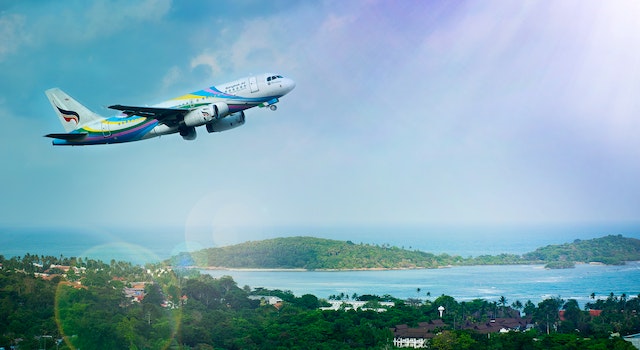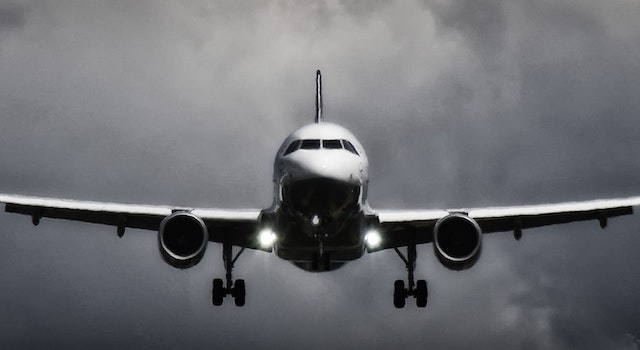Does Rain Delay Flights?
The weather doesn’t typically influence a flight in a significant way. When it is combined with strong winds, it creates more challenges when planning a flight. This can lead to an abrupt change in route or a delay if conditions are extreme. In general, planes are well-equipped to handle the rain!
Do Flights Have Delays Because Of Rain?
We will look at the connection between rain and delays on flights. We will address common misconceptions and offer valuable insight. Our goal is to arm readers with information that will assist them in understanding the effects that rain has on flight schedules, helping travelers organize their journeys more efficiently.
The Influence of Rain on Flight Operations
Rain, a natural weather phenomenon, can affect flight operations. But it is important to keep in mind that rain alone isn’t the primary cause of delays on flights. Modern aircraft are built and constructed to function safely under a variety of weather conditions, which include rain. Airlines follow strict safety guidelines and protocols issued by officials in the aviation industry to guarantee the safety of both crew and passengers.
Factors Affecting Flight Delays
Delays in flights can be due to a myriad of causes, and it is vital to think about the larger context when considering the effects of rain on flight operations. Here are a few of the most important factors that result in delays:
Weather Conditions
While rain alone may not directly lead to delays in flight, certain weather conditions connected with rain may affect the operations of aircraft. The heavy rain, accompanied by storms, strong winds, or poor visibility, can cause delays due to safety reasons. In these situations, airlines place the safety of passengers above all else. In such cases, they may decide to hold off until the conditions improve.
Airport Infrastructure
The facilities and infrastructure at an airport have a major impact on its capacity to deal with difficult weather conditions. Airports with inadequate drainage systems or inadequate runway traction can be delayed during heavy rain. However, the major airports usually invest in modern technology and infrastructure upgrades to prevent interruptions that are caused by rainfall.
Air Traffic Control
ATC (Air Traffic Control) regulates air traffic within the airspace. It ensures safe landings, takeoffs, and routing between locations. In the event of severe weather, ATC may implement restrictions or redirect flights to ensure security. These precautions are implemented to prevent incidents and minimize risks that could cause delays.
Aircraft Maintenance
Safety is of the utmost significance in the aviation industry, so frequent maintenance is crucial to ensure the correct functioning of all components. If severe rain or other weather-related conditions affect the exterior of the aircraft, airlines can conduct additional inspections or checks of maintenance prior to departure, which could lead to possible delays.
Mitigating the Impact of Rain on Flights
Although delays to flights due to rain are not uncommon, airports and airlines employ different strategies to limit the impacts on passengers. Here are some steps that can be implemented to minimize the effect that rain can have on flights
Preemptive Planning
Airlines monitor weather forecasts and adjust their plans in accordance with them. In anticipation of adverse weather conditions, airlines can alter flight schedules, improve ground operations, and limit the potential for disruptions due to rain.
Efficient Ground Handling
Airports with a well-trained ground crew and a well-functioning infrastructure are able to handle extreme weather conditions with greater ease. A well-drained runway, good equipment for de-icing, and an efficient process of boarding contribute to lessening delays and also ensuring more efficient operations during rainy times.
Timely Communication
Airlines are committed to maintaining regular and open communications with passengers during delays caused by weather. Fast notifications, timely updates regarding departure times, and alternate travel arrangements can help reduce discomfort and provide passengers with the necessary information needed to plan their travel plans.
Are Flights Still Flying, Even In The Rain?
We strive to give you the most current and accurate information about the topic. Put on your seatbelts and prepare for a thrilling journey into the aviation world and rain!
The Influence of Rain on Flights
The rain certainly affects the various aspects of our lives. From soaking umbrellas to sloppy shoes, it’s obvious that rain can cause inconveniences. But in the case of commercial air flights, weather by itself is rarely the deciding factor in determining if an aircraft is able to take off. Modern aviation technology and rigorous safety standards make sure that flights run smoothly, even in bad conditions.
Aircraft Design and Rain
One of the main factors that allow aircraft to function during rain is the aircraft’s perfect design and engineering. The manufacturers consider the effects of rain when they design aircraft, making sure that the aircraft can withstand the elements without harming safety. From the aerodynamic design of the fuselage to the components used for construction, each aspect is selected to minimize the effect of rain on flights.
Runway Surface and Rain
Another important aspect to take into consideration is runway condition. Airports are meticulously maintaining their runways to ensure safety in any weather condition, even rain. The runway’s surface is adorned with particular design elements like grooves and slopes to aid in the efficient drainage of water. Furthermore, airports employ advanced water dispersal systems that reduce the amount of water that accumulates on runways, thereby decreasing the risk of rainy conditions.
Pilot Training and Rainy Conditions
When it comes to making sure that you can have a safe flight in wet conditions, the skills and experience of pilots play an important role. Pilots receive rigorous training that incorporates simulations and actual scenarios that involve adverse weather conditions, like rain. The training programs provide pilots with the required capabilities to face a variety of weather-related issues, enabling them to make informed choices on the fly.
Enhanced Weather Monitoring Systems
The advancement of technology has revolutionized the way that weather data is tracked for aviation. Weather radar systems in aircraft offer real-time information regarding precipitation patterns, which allows pilots to navigate through areas with heavy rainfall if necessary. Air traffic control facilities closely check weather conditions and provide constant updates to pilots, making sure that flights are able to adapt to changing weather cat change.
Rain-Related Flight Delays
Although flights are constructed and equipped to withstand rain, it’s vital to recognize that extreme weather conditions could result in delays due to various reasons. Strong winds, thunderstorms, or heavy downpours could affect the schedule of flights due to security issues. Airports and airlines put the safety of passengers above everything else. If conditions are considered unsafe, flights could be delayed until conditions improve.
Passenger Comfort and Rain
Beyond the technical aspect, airlines also focus on the comfort of passengers during rainy conditions. Aircraft are equipped with sophisticated technology for controlling the climate that controls the temperature and humidity, ensuring an enjoyable environment regardless of the weather. Even if it’s raining outside, passengers are able to sit in a comfortable position, relax, and enjoy a pleasant flight.
Do Planes Fly In Storms?
Before we can get into the issue at hand, it is essential to be aware of the nature of thunderstorms and how they occur. Thunderstorms are a severe weather phenomenon that is characterized by lightning and thunder, as well as heavy rain, strong winds, and occasionally hail. They are often linked to cumulonimbus clouds, which are massive and vertically soaring clouds that have flat, flat tops.
Safety Comes First
Safety is the top priority in the aviation industry above all else. This is true even when flying through all weather conditions, such as thunderstorms. Pilots and airlines adhere to strict guidelines and regulations imposed by aviation authorities in order to protect passengers as well as crew members.
Avoidance and Mitigation
When it comes to storms, generally speaking, the best practice for planes is to stay clear of them at all costs. Pilots are provided with precise weather reports and updated information prior to every flight, allowing them to make educated decisions about the most secure route to follow. The advanced weather radar systems that are installed on modern aircraft aid pilots in identifying and circumnavigating storm cells.
The Impact of Lightning
One of the major problems associated with thunderstorms, as well as flying, is the threat of lightning. Although it can look visually stunning and thrilling, it is never a major danger to aircraft. Modern aircraft are constructed to withstand the impact of lightning. They are built with conductors and have a variety of security measures to disperse electrical energy without impacting the aircraft’s vital systems.
Turbulence and Updrafts
Another factor that has raised questions about flying is turbulence, as well as updrafts. Thunderstorms are known for their turbulent air currents and strong updrafts. Pilots are nevertheless provided with regularly updated information on the weather, which allows them to stay clear of the turbulent zones caused by storms. In addition, air traffic controllers are constantly working together with the pilots to ensure that transportation is safe and efficient in extreme weather conditions.
Reducing Risks Through Technology
Technology advancements have helped reduce the risk of flying during storms. Systems for monitoring weather conditions, including ground-based radar and weather satellites, give real-time information about storm activity. The information provided by these systems lets pilots make informed choices and alter their flight plans in accordance with the latest information to ensure the safety of all aboard.
Expertise and Training
Pilots receive extensive training to manage different weather conditions, such as storms. They receive specific instruction in weather patterns, meteorology, and the best way to interpret weather reports accurately. This experience, coupled with their expertise and the direction given by air traffic control, makes sure that aircraft can successfully and safely navigate difficult weather conditions.
FAQ’s
Does rain delay flights?
Yes, rain can potentially delay flights depending on various factors such as the intensity of the rainfall, visibility conditions, and the type of aircraft involved. Flight delays due to rain are usually precautionary measures taken by airlines to ensure the safety of passengers and crew.
How does rain affect flight operations?
Rain can impact flight operations in several ways. Heavy rain can reduce visibility, making it difficult for pilots to navigate and land safely. It can also cause water accumulation on runways, leading to reduced friction and longer stopping distances for aircraft during takeoff and landing.
Are all flights delayed during rainstorms?
Not all flights are necessarily delayed during rainstorms. Airlines and airport authorities have protocols in place to manage different weather conditions. While some flights may experience delays due to safety concerns, others may continue to operate on schedule if the rain is light and visibility remains good.
How long can a flight be delayed due to rain?
The duration of a flight delay caused by rain can vary significantly. It depends on factors such as the severity of the rain, the airport’s infrastructure and capacity to handle adverse weather conditions, and the availability of alternate routes or airports. Delays can range from a few minutes to several hours.
Can airlines predict rain-related flight delays in advance?
Airlines have access to weather forecasting systems that provide them with information on upcoming rainstorms. Based on these forecasts, they can make informed decisions about flight schedules and potential delays. However, weather conditions can change rapidly, making it challenging to predict delays with absolute certainty.
What happens if my flight is delayed due to rain?
If your flight is delayed due to rain, the airline will typically provide you with updates on the status of the flight. They may offer alternative arrangements, such as rebooking on a later flight or providing accommodation if necessary. It’s essential to stay in touch with the airline and follow their instructions during such situations.
Does Rain Delay Flights?
The weather doesn’t typically influence a flight in a significant way. When it is combined with strong winds, it creates more challenges when planning a flight. This can lead to an abrupt change in route or a delay if conditions are extreme. In general, planes are well-equipped to handle the rain!
Do Flights Have Delays Because Of Rain?
We will look at the connection between rain and delays on flights. We will address common misconceptions and offer valuable insight. Our goal is to arm readers with information that will assist them in understanding the effects that rain has on flight schedules, helping travelers organize their journeys more efficiently.
The Influence of Rain on Flight Operations
Rain, a natural weather phenomenon, can affect flight operations. But it is important to keep in mind that rain alone isn’t the primary cause of delays on flights. Modern aircraft are built and constructed to function safely under a variety of weather conditions, which include rain. Airlines follow strict safety guidelines and protocols issued by officials in the aviation industry to guarantee the safety of both crew and passengers.
Factors Affecting Flight Delays
Delays in flights can be due to a myriad of causes, and it is vital to think about the larger context when considering the effects of rain on flight operations. Here are a few of the most important factors that result in delays:
Weather Conditions
While rain alone may not directly lead to delays in flight, certain weather conditions connected with rain may affect the operations of aircraft. The heavy rain, accompanied by storms, strong winds, or poor visibility, can cause delays due to safety reasons. In these situations, airlines place the safety of passengers above all else. In such cases, they may decide to hold off until the conditions improve.
Airport Infrastructure
The facilities and infrastructure at an airport have a major impact on its capacity to deal with difficult weather conditions. Airports with inadequate drainage systems or inadequate runway traction can be delayed during heavy rain. However, the major airports usually invest in modern technology and infrastructure upgrades to prevent interruptions that are caused by rainfall.
Air Traffic Control
ATC (Air Traffic Control) regulates air traffic within the airspace. It ensures safe landings, takeoffs, and routing between locations. In the event of severe weather, ATC may implement restrictions or redirect flights to ensure security. These precautions are implemented to prevent incidents and minimize risks that could cause delays.
Aircraft Maintenance
Safety is of the utmost significance in the aviation industry, so frequent maintenance is crucial to ensure the correct functioning of all components. If severe rain or other weather-related conditions affect the exterior of the aircraft, airlines can conduct additional inspections or checks of maintenance prior to departure, which could lead to possible delays.
Mitigating the Impact of Rain on Flights
Although delays to flights due to rain are not uncommon, airports and airlines employ different strategies to limit the impacts on passengers. Here are some steps that can be implemented to minimize the effect that rain can have on flights
Preemptive Planning
Airlines monitor weather forecasts and adjust their plans in accordance with them. In anticipation of adverse weather conditions, airlines can alter flight schedules, improve ground operations, and limit the potential for disruptions due to rain.
Efficient Ground Handling
Airports with a well-trained ground crew and a well-functioning infrastructure are able to handle extreme weather conditions with greater ease. A well-drained runway, good equipment for de-icing, and an efficient process of boarding contribute to lessening delays and also ensuring more efficient operations during rainy times.
Timely Communication
Airlines are committed to maintaining regular and open communications with passengers during delays caused by weather. Fast notifications, timely updates regarding departure times, and alternate travel arrangements can help reduce discomfort and provide passengers with the necessary information needed to plan their travel plans.
Are Flights Still Flying, Even In The Rain?
We strive to give you the most current and accurate information about the topic. Put on your seatbelts and prepare for a thrilling journey into the aviation world and rain!
The Influence of Rain on Flights
The rain certainly affects the various aspects of our lives. From soaking umbrellas to sloppy shoes, it’s obvious that rain can cause inconveniences. But in the case of commercial air flights, weather by itself is rarely the deciding factor in determining if an aircraft is able to take off. Modern aviation technology and rigorous safety standards make sure that flights run smoothly, even in bad conditions.
Aircraft Design and Rain
One of the main factors that allow aircraft to function during rain is the aircraft’s perfect design and engineering. The manufacturers consider the effects of rain when they design aircraft, making sure that the aircraft can withstand the elements without harming safety. From the aerodynamic design of the fuselage to the components used for construction, each aspect is selected to minimize the effect of rain on flights.
Runway Surface and Rain
Another important aspect to take into consideration is runway condition. Airports are meticulously maintaining their runways to ensure safety in any weather condition, even rain. The runway’s surface is adorned with particular design elements like grooves and slopes to aid in the efficient drainage of water. Furthermore, airports employ advanced water dispersal systems that reduce the amount of water that accumulates on runways, thereby decreasing the risk of rainy conditions.
Pilot Training and Rainy Conditions
When it comes to making sure that you can have a safe flight in wet conditions, the skills and experience of pilots play an important role. Pilots receive rigorous training that incorporates simulations and actual scenarios that involve adverse weather conditions, like rain. The training programs provide pilots with the required capabilities to face a variety of weather-related issues, enabling them to make informed choices on the fly.
Enhanced Weather Monitoring Systems
The advancement of technology has revolutionized the way that weather data is tracked for aviation. Weather radar systems in aircraft offer real-time information regarding precipitation patterns, which allows pilots to navigate through areas with heavy rainfall if necessary. Air traffic control facilities closely check weather conditions and provide constant updates to pilots, making sure that flights are able to adapt to changing weather cat change.
Rain-Related Flight Delays
Although flights are constructed and equipped to withstand rain, it’s vital to recognize that extreme weather conditions could result in delays due to various reasons. Strong winds, thunderstorms, or heavy downpours could affect the schedule of flights due to security issues. Airports and airlines put the safety of passengers above everything else. If conditions are considered unsafe, flights could be delayed until conditions improve.
Passenger Comfort and Rain
Beyond the technical aspect, airlines also focus on the comfort of passengers during rainy conditions. Aircraft are equipped with sophisticated technology for controlling the climate that controls the temperature and humidity, ensuring an enjoyable environment regardless of the weather. Even if it’s raining outside, passengers are able to sit in a comfortable position, relax, and enjoy a pleasant flight.
Do Planes Fly In Storms?
Before we can get into the issue at hand, it is essential to be aware of the nature of thunderstorms and how they occur. Thunderstorms are a severe weather phenomenon that is characterized by lightning and thunder, as well as heavy rain, strong winds, and occasionally hail. They are often linked to cumulonimbus clouds, which are massive and vertically soaring clouds that have flat, flat tops.
Safety Comes First
Safety is the top priority in the aviation industry above all else. This is true even when flying through all weather conditions, such as thunderstorms. Pilots and airlines adhere to strict guidelines and regulations imposed by aviation authorities in order to protect passengers as well as crew members.
Avoidance and Mitigation
When it comes to storms, generally speaking, the best practice for planes is to stay clear of them at all costs. Pilots are provided with precise weather reports and updated information prior to every flight, allowing them to make educated decisions about the most secure route to follow. The advanced weather radar systems that are installed on modern aircraft aid pilots in identifying and circumnavigating storm cells.
The Impact of Lightning
One of the major problems associated with thunderstorms, as well as flying, is the threat of lightning. Although it can look visually stunning and thrilling, it is never a major danger to aircraft. Modern aircraft are constructed to withstand the impact of lightning. They are built with conductors and have a variety of security measures to disperse electrical energy without impacting the aircraft’s vital systems.
Turbulence and Updrafts
Another factor that has raised questions about flying is turbulence, as well as updrafts. Thunderstorms are known for their turbulent air currents and strong updrafts. Pilots are nevertheless provided with regularly updated information on the weather, which allows them to stay clear of the turbulent zones caused by storms. In addition, air traffic controllers are constantly working together with the pilots to ensure that transportation is safe and efficient in extreme weather conditions.
Reducing Risks Through Technology
Technology advancements have helped reduce the risk of flying during storms. Systems for monitoring weather conditions, including ground-based radar and weather satellites, give real-time information about storm activity. The information provided by these systems lets pilots make informed choices and alter their flight plans in accordance with the latest information to ensure the safety of all aboard.
Expertise and Training
Pilots receive extensive training to manage different weather conditions, such as storms. They receive specific instruction in weather patterns, meteorology, and the best way to interpret weather reports accurately. This experience, coupled with their expertise and the direction given by air traffic control, makes sure that aircraft can successfully and safely navigate difficult weather conditions.
FAQ’s
Does rain delay flights?
Yes, rain can potentially delay flights depending on various factors such as the intensity of the rainfall, visibility conditions, and the type of aircraft involved. Flight delays due to rain are usually precautionary measures taken by airlines to ensure the safety of passengers and crew.
How does rain affect flight operations?
Rain can impact flight operations in several ways. Heavy rain can reduce visibility, making it difficult for pilots to navigate and land safely. It can also cause water accumulation on runways, leading to reduced friction and longer stopping distances for aircraft during takeoff and landing.
Are all flights delayed during rainstorms?
Not all flights are necessarily delayed during rainstorms. Airlines and airport authorities have protocols in place to manage different weather conditions. While some flights may experience delays due to safety concerns, others may continue to operate on schedule if the rain is light and visibility remains good.
How long can a flight be delayed due to rain?
The duration of a flight delay caused by rain can vary significantly. It depends on factors such as the severity of the rain, the airport’s infrastructure and capacity to handle adverse weather conditions, and the availability of alternate routes or airports. Delays can range from a few minutes to several hours.
Can airlines predict rain-related flight delays in advance?
Airlines have access to weather forecasting systems that provide them with information on upcoming rainstorms. Based on these forecasts, they can make informed decisions about flight schedules and potential delays. However, weather conditions can change rapidly, making it challenging to predict delays with absolute certainty.
What happens if my flight is delayed due to rain?
If your flight is delayed due to rain, the airline will typically provide you with updates on the status of the flight. They may offer alternative arrangements, such as rebooking on a later flight or providing accommodation if necessary. It’s essential to stay in touch with the airline and follow their instructions during such situations.










